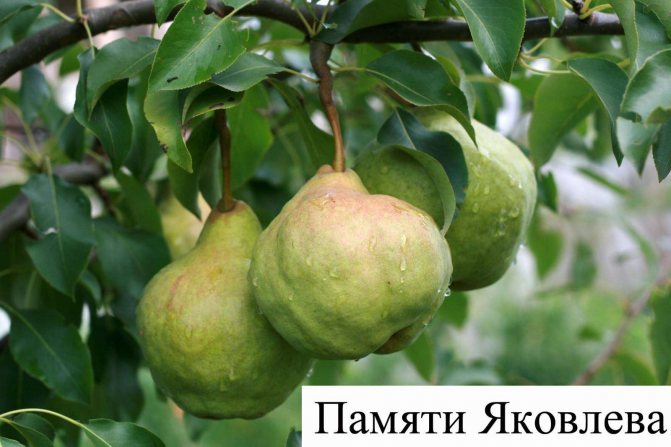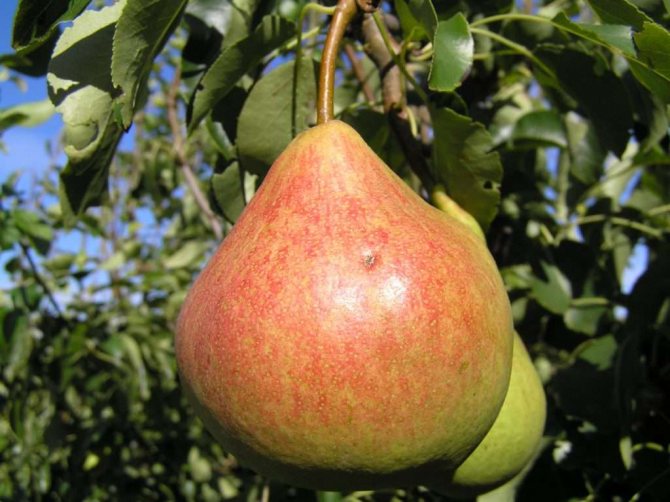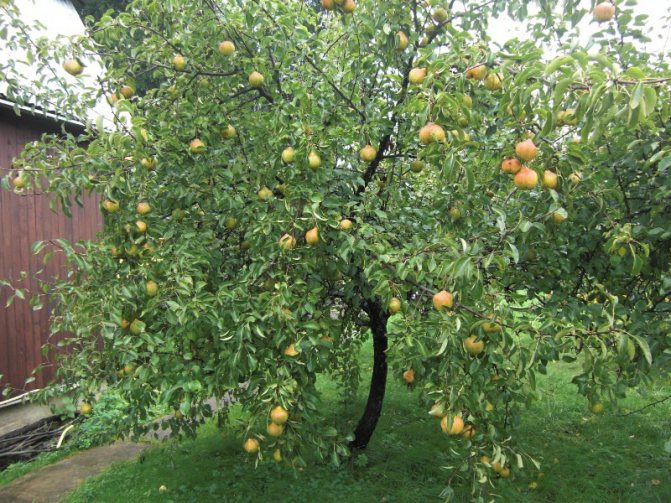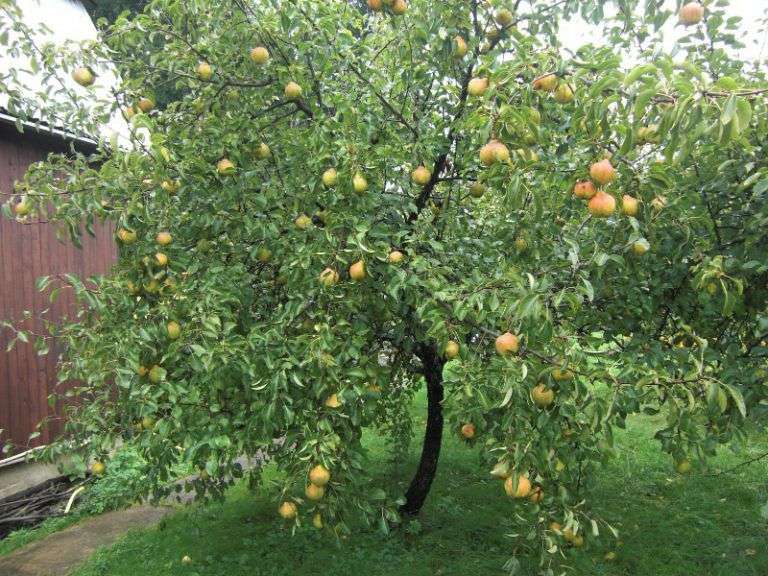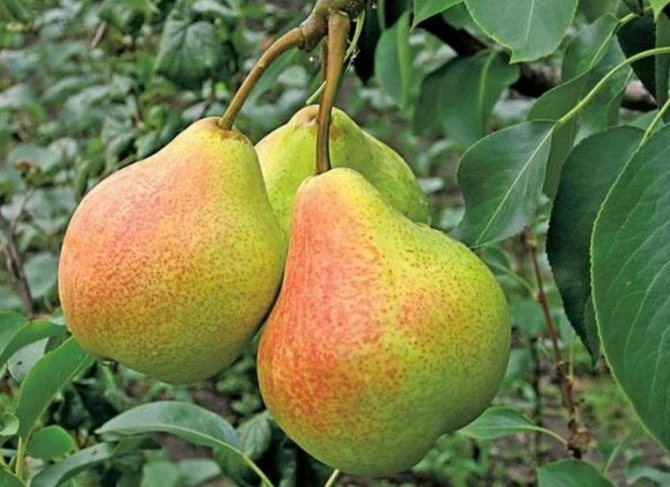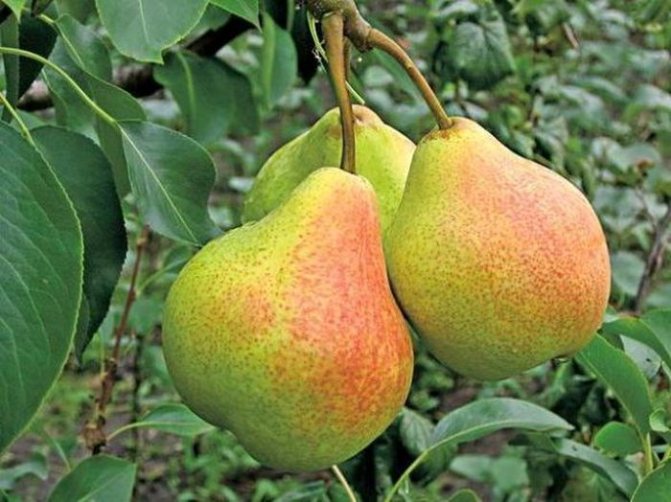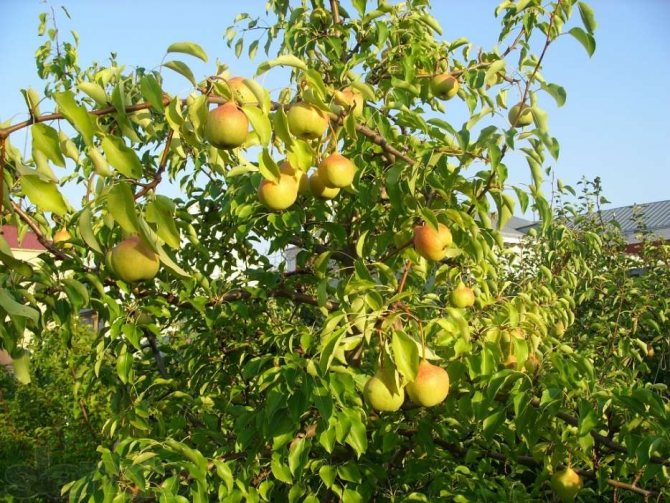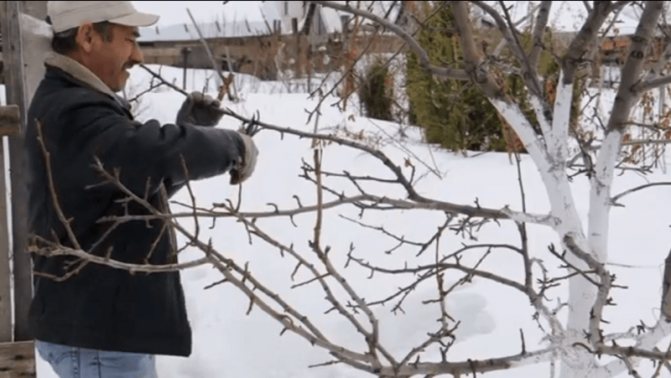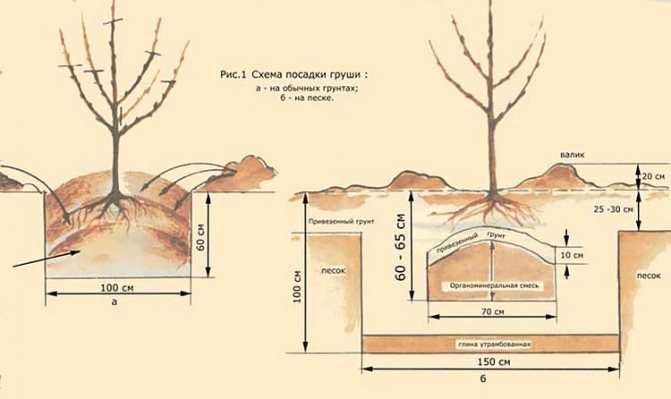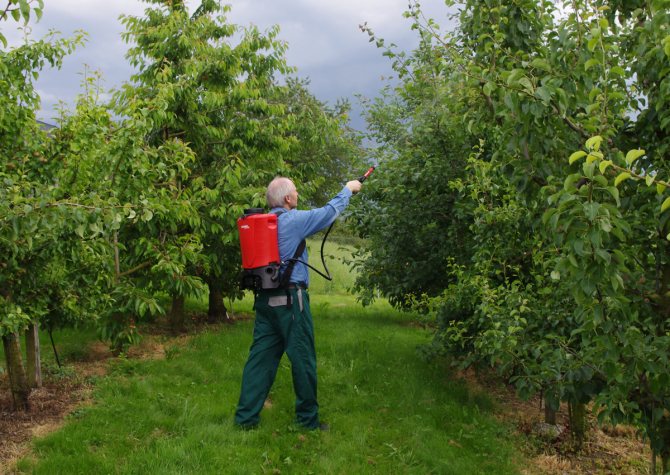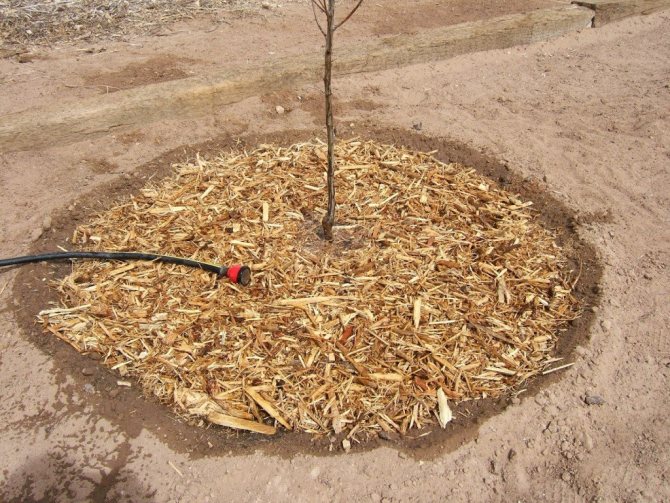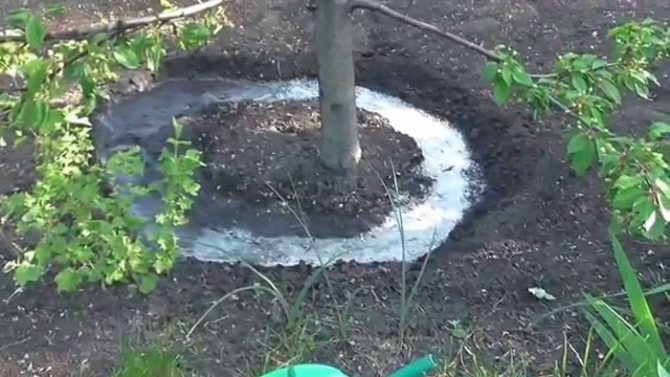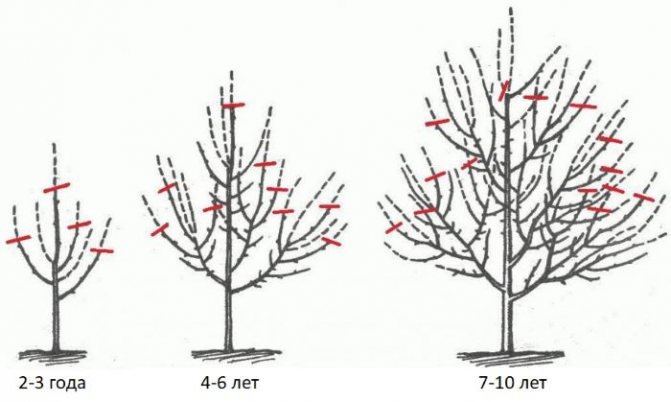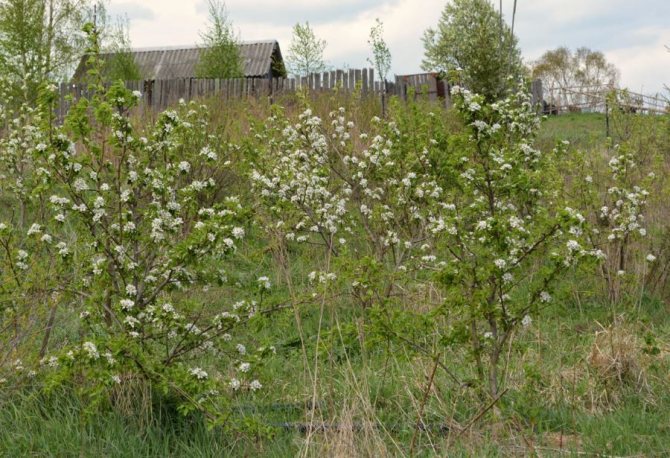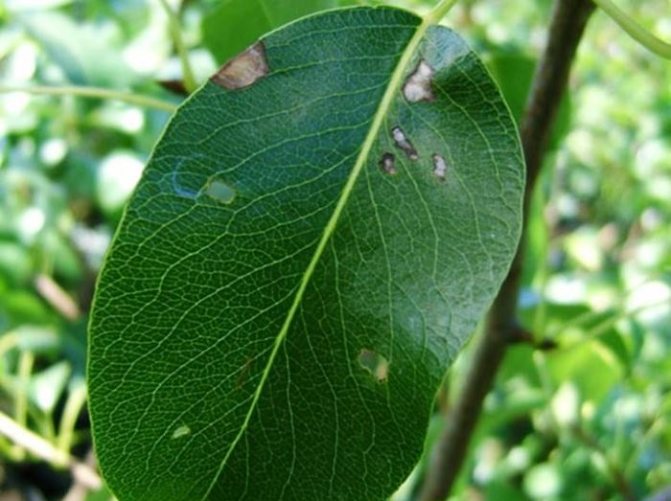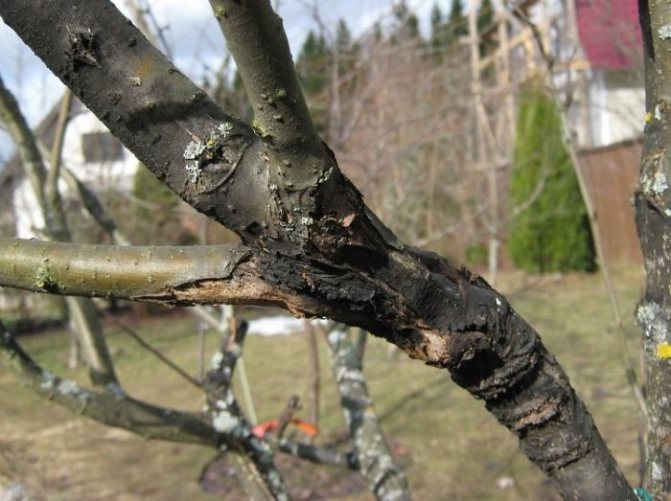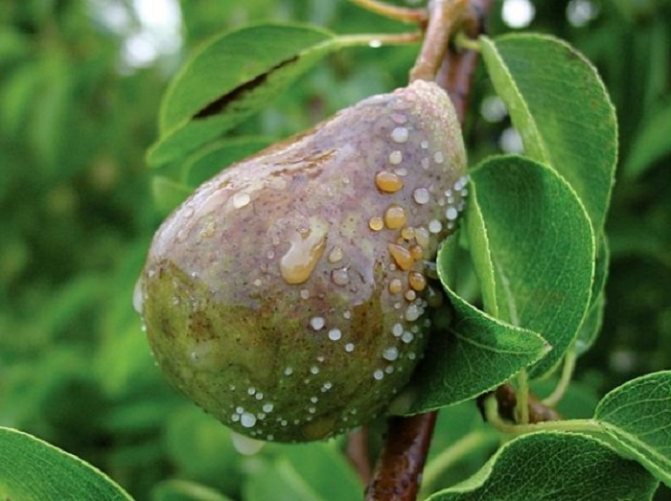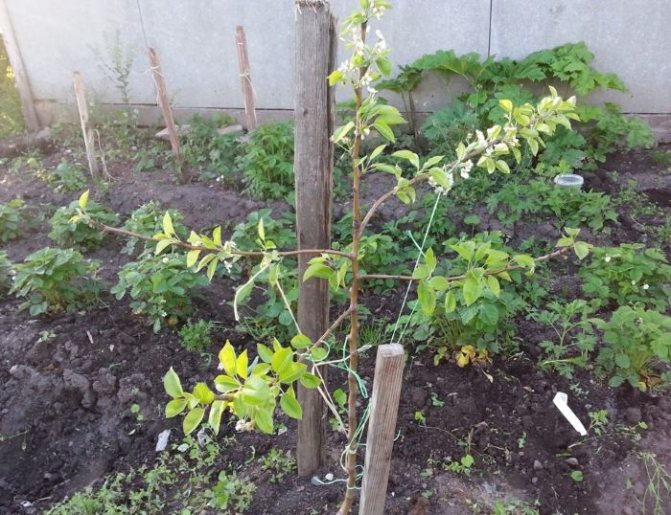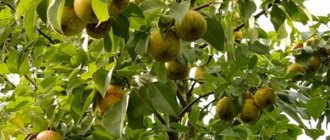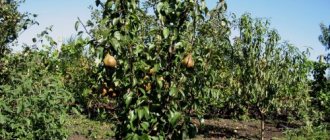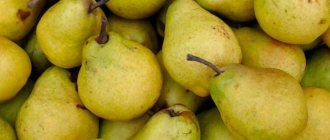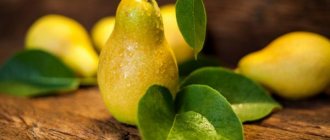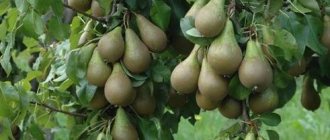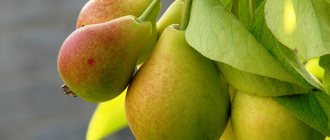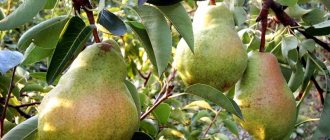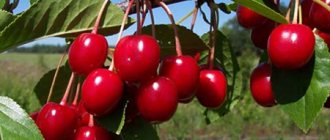The history of breeding varieties in Memory of Yakovlev
The name of the variety immortalized the name of the famous Soviet breeder, a student of I. Michurin himself, who in the middle of the last century began work on the development of a frost-resistant and hardy fruit tree based on the Ussuri pear. This variety of wild-growing pear is well known to the inhabitants of Primorye, the Far East, as well as some regions of China and Korea.
Did you know? The life span of a pear tree is very long: it can range from 100 to 150 years with an average fruiting period of 50 years. But there are exceptions, for example, in the Belgorod-Dnestrovsky district of the Odessa region, a pear grows, the approximate age of which is 350-400 years!
The breeding work was carried out by Pavel Nikanorovich Yakovlev and his assistants in the Tambov region on the basis of the State Scientific Institution “All-Russian Research Institute of Genetics and Breeding of Fruit Plants named after V.I. IV Michurin ", as well as Michurinsky Agrarian University. It was there that frost-resistant pear varieties that became popular throughout Russia were born, such as Osennyaya Yakovleva, Severyanka, Svetlyanka.
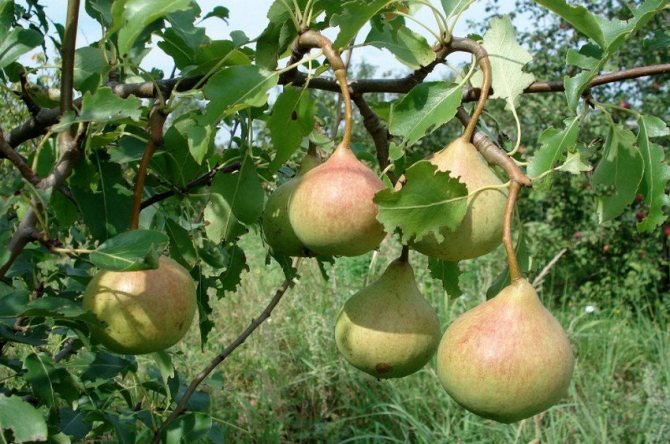
Among the numerous experiments carried out by scientists with the Ussuri pear as a parental form was the crossing of one of its varieties called Tema with a dessert pear, bred by the Frenchman A.T. Baubunel in the city of Rouen back in 1851 and known as Olivier de Serre. However, for some reason, the experiments did not give the expected result for a long time, and PN Yakovlev did not live to complete the work on the hybrid.
Check out such autumn pear varieties as:
Description of the variety
This variety belongs to the category of fast-growing and low-growing pears, the height of which reaches only two meters.
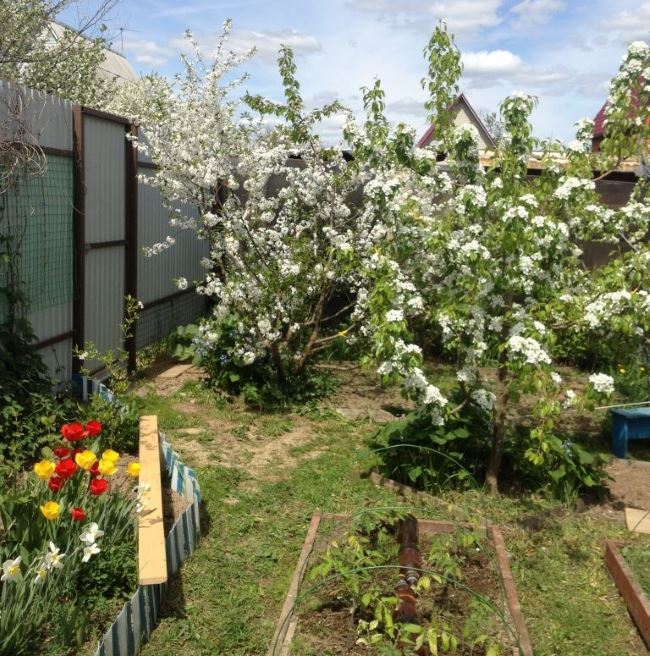

A fast-growing tree with a rounded crown of medium density.
- Crown it has spherical, medium and symmetrical thickening.
- Bark color gray, smooth shoots.
- Branch divergence occurs at a right angle, after years, annuli are formed.
- Escapes are brown in color, thorns and lentils are quite common.
- Kidney are tapered, slightly curved and smooth.
- Leaves dark green in color, petioles 2 cm long, serrate along the edge, the apex is slightly twisted and ovoid. They themselves are leathery.
Fruit
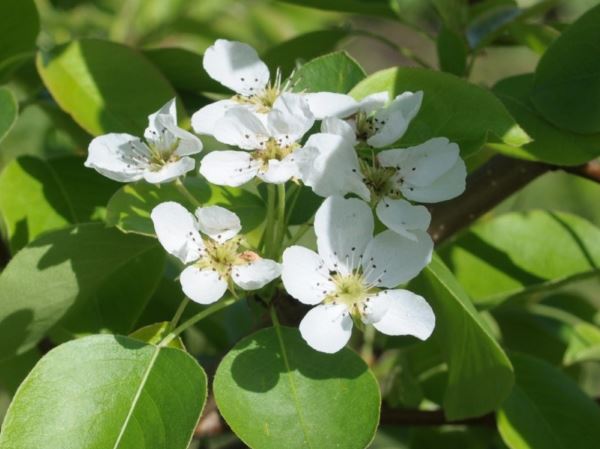

Partially self-pollinated flowers.
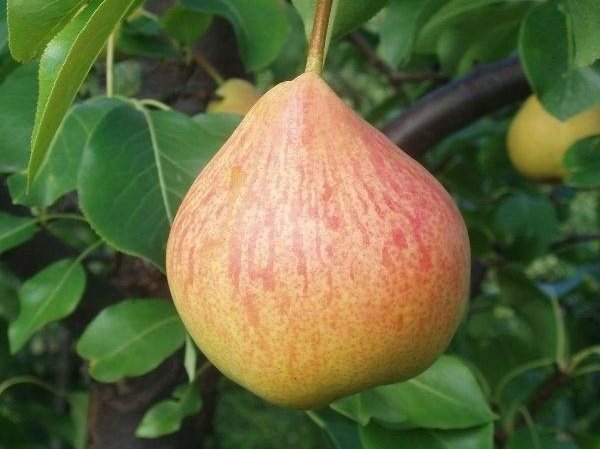

Large fruit.
The inflorescences are white and have large, separate petals. Inflorescences have 5-7 flowers.
- The fruits are quite large and their weight is about 200 g.
- Skin they are smooth and have a golden yellow color.
- The length of the curved peduncle is 5 cm.
- Ripening period falls in September, if they are not removed in time, they will begin to crumble quickly.
- Fruit pulp always incredibly juicy and sweet, no astringency. Pears contain a huge amount of useful acids, catechins, arbutins and sugar. The first fruiting begins five years after planting.
- The yield will increase every year.... Even from a small eight-year tree, it will be possible to collect about 20 Kg juicy fruits.
Description and characteristics of the tree and fruits
Describing the botanical features of the Yakovlev memory pear, one can note the following main characteristics:
| Wood | Stunted (no more than 2 m), compact, vigor of growth and formation of shoots is high. |
| Crown | Rounded, medium thickening, the angle of direction of the skeletal branches is almost straight. |
| Bark | On the trunk it is gray, with strong peeling, on the branches it is light brown. |
| Branches | Not very thick, covered with thorns, slightly knobby, elbow-shaped. |
| Kidney | Cone-shaped, smooth, curved, with a large subrenal pad and good awakening ability. |
| Leaves | Small, bright green, in the form of an oval expanding to the tip with jagged edges, leathery plate, strongly curved at the end and slightly curved in width. |
| Petioles | Long. |
| Stipules | Lanceolate, small in size. |
| Flowers | White, collected in inflorescences of 4-6 pieces, the petals are smooth and separate. |
| Fruiting type | Ringed, branched and numerous ringlets, can be simple or complex. |
The fruits of the pear in Memory of Yakovlev have the following features:
- Dimensions (edit) - unequal, especially with a good harvest - the average weight of one pear ranges from 120–150 g, but both smaller and larger specimens may come across.
- The form - wide, with a narrow saucer and a shallow funnel.
- Skin structure - smooth, shiny, sometimes very bumpy, almost without subcutaneous points.
- Skin color - light yellow with a small orange barrel, darker to orange as it matures.
- Peduncle - long and strongly curved.
- Pulp - the color of baked milk, juicy, sweet with barely expressed sourness (sugar content up to 12.2%, acid - 0.25%), semi-oily, graininess is weak, mainly appears closer to the center of the fruit, in some cases astringency and bitterness are present.


Flowering and ripening period
Blossoms in Memory of Yakovlev in late April - early May, the fruits reach technical ripeness in late September. The tree begins fruiting from the 4th or 5th year after planting.
Pollination and yield of pear varieties in Memory of Yakovlev
In memory of Yakovlev, unlike the overwhelming majority of pears, it has good self-fertility and does not need pollinators. However, the presence of those allows you to increase the yield of the variety, therefore it is better to plant other varieties of pears on the site, blooming at the same time as the main one.
Did you know? The origin of the name "pear" is not known for certain, although already in the Russian chronicles of the 12th century there was a fruit called "hrusha". There is a version that the word is etymologically related to the Kurdish “kuresi”, from which, in turn, came the ancient Prussian “crausy”, the Czech “hruška” and the Polish “gruszka”.
For example, varieties such as:
- Augustow;
- Space;
- Forest beauty;
- Severyanka;
- Lada;
- Rogneda;
- Chizhovskaya;
- Otradnenskaya;
- Winter decanter;
- Williams is summer.
The yield of the variety depends on the age of the tree. So, already in the first 2-3 years after the beginning of fruiting, 20 kg of fruit can be harvested from one pear, later this figure rises slightly with good care.
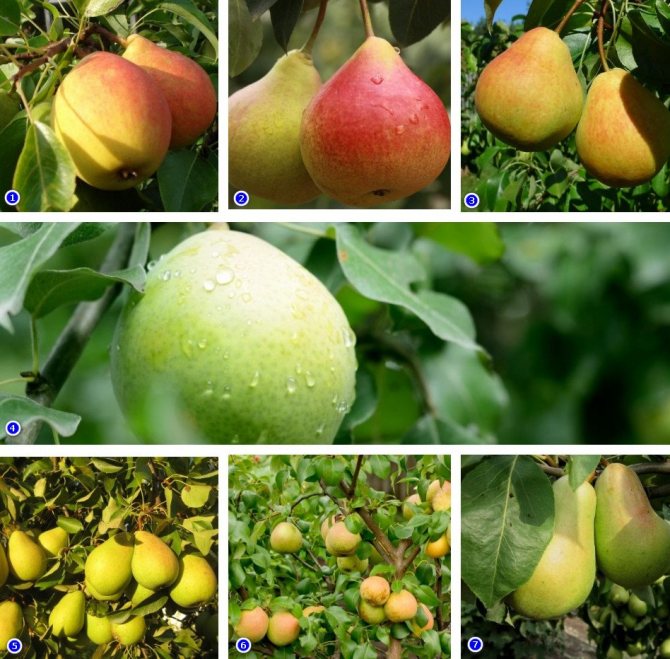

1 - Forest beauty; 2 - Severyanka; 3 - Lada; 4 - Rogneda; 5 - Chizhovskaya; 6 - Otradnenskaya; 7 - Williams is summer. A feature of Yakovlev's Memory is the manifestation of some cyclicity in fruiting, that is, the yield, with its generally good indicators, is irregular and unstable. The purpose of the fruits is universal, pears are equally good when eaten fresh and in preparations (preserves, jams, compotes, etc.).
Gardeners reviews
This variety requires regular maintenance, which consists in abundant watering, spraying with special mixtures and periodic fertilization.
The advantages of the pear variety "In Memory of Yakovlev" include early maturity, high winter hardiness, resistance to scab and other diseases, and good transportability.
The disadvantage is the presence of stony cells, in addition, with age, fruits of an uneven, knobby shape are formed.
Despite the shortcomings, the variety is one of the most popular among Russian gardeners.
Below is a photo of a pear "In Memory of Yakovlev".
The cultivar developed by breeders is very attractive for cultivation. Quite simple care is within the power of even beginner gardeners. Long-term cultivation of the variety in the middle lane brought many positive reviews to him, but there are also dissatisfied ones.
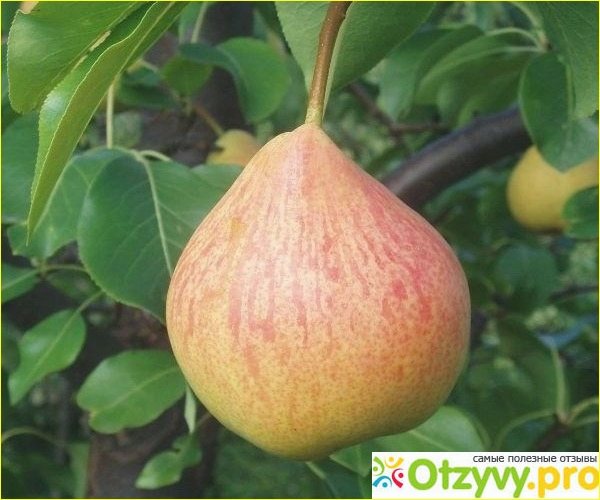

This can be explained by insufficient care, the acquisition of a seedling of dubious origin from unscrupulous sellers.
Andrey Ilyushin, Volgograd region
Gardener, Ilyinsk
Tatjanap, Pyshnyansk
Yri, Michurinsk
Vnuchek Michurin, Moscow
- The variety is very productive. In some years, he collected up to 25 g of tasty fruits. The tree grows very quickly and already on the third ode you can taste the first pears. They are very tasty and large. The variety loves timely watering and pruning. The crops are stored well in the basement and are very suitable for making jam. Winter trees are normal. Good grade.
- I have been growing this variety in the country for a very long time. Was always with the harvest. I collected from 13 to 26 kg from a tree. fruits. The variety is very rarely affected by diseases. Of the pests, of course, the pear moth is the most troublesome. But with a double treatment with insecticides, the problem is easily solved. The harvested pears are very tasty and have a long shelf life. The variety is winter-hardy and tolerates dry periods quite well. I'm happy with the variety. I recommend it to all gardeners.
- An excellent variety. I have been growing for the third year and have already tasted the first fruits. The taste is great. The seedling took root very well and began to grow rapidly. In the first winter, I insulated it. In subsequent years, the overwintering went well, without any insulation. In the basement, grown pears can be stored for up to two months. Sorry, the jam from them is magnificent. The variety is drought tolerant and loves feeding.
- For a long time I was looking for the best pear variety for myself. I tried many varieties, but the best variety was still in memory of Yakovlev. Trees practically do not get sick and always provide a good harvest. In some years, he collected 20 kg. from the tree. The pears are delicious and beautiful. The variety overwinters well. During cultivation, you need to carefully thin out the crown and feed. An excellent variety. You will not regret.
Advantages and disadvantages of the variety in Memory of Yakovlev
- The list of benefits should first include:
- winter hardiness, including resistance to sudden temperature changes, which manifests itself even in young seedlings;
- unpretentiousness;
- resistance to many fungal diseases;
- compact size of the tree;
- fast entry into the fruiting phase;
- self-fertility (often used as a pollinator for other pears);
- excellent retention of pears on the stalks, no tendency to fall prematurely;
- keeping quality and transportability of fruits.
- In particular, gardeners note this pear:
- low drought resistance (yield indicators directly depend on the intensity of irrigation);
- unequal sizes of fruits, which reduces their commercial characteristics;
- the presence of "stony" areas in the pulp of pears, especially in older trees;
- average yields (there are varieties of pears that yield up to 100 kg or more of fruits from one tree), significantly decreasing with age;
- a decrease in the quality of pears as the tree ages;
- the presence of bitterness and astringency in fruits when growing varieties on sandy soil.
Important! It should be understood that the low yield rates of Pamyat Yakovlev are partially compensated by the short stature and compactness of the tree, which makes it possible to increase the planting density and obtain higher yields from the same area.
Pollination and pollinators
Yakovlev's Memory Pear is self-fertile and does not require pollinating plants. This is a very useful quality if you have a small garden area. However, to enhance fruiting, it is recommended to plant varietal trees of August or Lada pears in the neighborhood.
The culture itself can act as a pollinator for some trees that bloom with it at the same time.
The variety has low self-fertility. To obtain a high yield, the pear “Yakovlev's favorite” needs a neighborhood with other trees. Pollinators are other varieties. It is believed that the best of them is “summer duchess”.
Planting pear varieties in memory of Yakovlev
You can plant a pear in Memory of Yakovlev in spring or autumn. Experts recommend using the first of these options for the variety. However, in both cases, it is necessary to start choosing a site and preparing a hole in advance: when planting in spring, it is better to dig a hole in the fall, in autumn - at least two weeks in advance, so that the organic composition of the soil at the bottom has time to naturally balance.
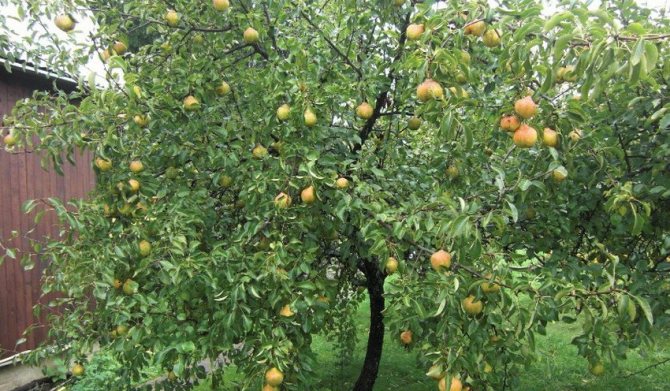

The main requirements for the soil
For planting a variety, it is necessary to select a site with fertile and light soil. The reaction of the soil should be neutral or slightly acidic. Pears grow very poorly on clay soils, however, as already mentioned, the increased sand content negatively affects the taste of the variety, so loam is best suited for it. Heavy soil can be lightened by adding peat or sand to the soil removed from the pit. Better yet, mix these components with chernozem specially brought to the site.
Did you know? It is difficult to surprise someone with apples and pears. However, it turns out that a hybrid of these two fruits, called "neshi" and having a rather dense, but very juicy and crunchy pulp, was bred in Asia many centuries ago and has since been successfully grown.
The place for the seedling should be open, well-lit, even and preferably located on a small elevation (stagnation of water in the root system, which occurs after spring floods or due to the proximity of groundwater, has a detrimental effect on the tree). If there are other trees on the site, make sure that the distance from the site chosen for planting to any of them does not exceed 4 m.
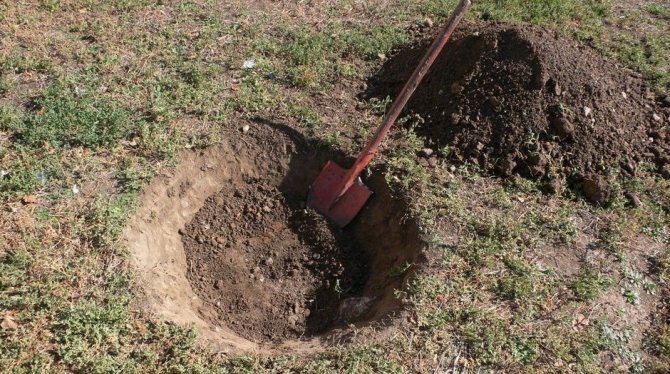

Landing pit size 80x80
Preparation of planting material
Yakovlev's Memory Pear is very difficult to transfer, so the less time the seedling root system spends outside the soil, the better. Based on these considerations, planting material should be purchased immediately before planting and as close to your site as possible in order to exclude long transportation. In favor of this rule, it should also be noted that trees take root much easier if they are planted in climatic conditions as close as possible to the first landing site.
You will be interested in learning how to grow a decorative pear.
The optimal place for purchasing a seedling is a specialized nursery, this is the only way to be sure that the tree meets the varietal affiliation and is grown in compliance with all agrotechnical standards. If there is no such nursery in the region closest to the site, and the seedling will need to be transported over a long distance, first, the root system of the tree should be wrapped in a damp cloth, and additionally soaked before planting.
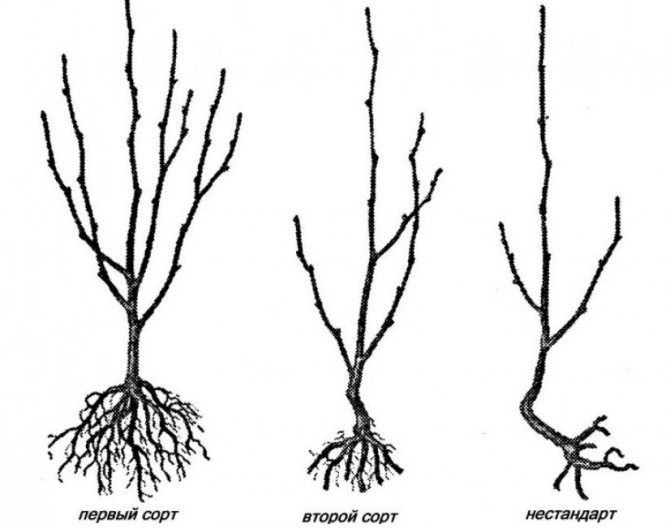

Healthy and high-quality planting material is the key to a good harvest.
Landing rules and scheme
The technology of planting pears in Memory of Yakovlev involves the sequential implementation of the following procedures:
- Dig a hole 80x80x80 cm in size.
- Remove the bottom layer of earth, removed from the pit, it is considered infertile and is not suitable for growing a young tree.
- Use the top layer of the earth as a basis for the preparation of the nutrient substrate.To do this, add to it: 15–20 liters of sand, 20–30 liters of humus or compost, 100 ml of superphosphate, 50 ml of potassium sulfate and 500 ml of wood ash.
- After the pit has “settled down” (at least two weeks), pour 25 liters of the prepared soil mixture onto its bottom and shovel it towards the center in the form of a mound.
- Drive a wooden peg into the middle of the mound as a support.
- Place the seedling on the north side of the support, grafting to the south.
- Spread the roots of the tree along the slope of the earth.
- Fill the hole with soil mixture to a level where 6–7 cm remains between the root collar and the ground.
- Tamp the soil and water abundantly.
- When the water is completely absorbed, add fresh soil or peat to the trunk circle so that the root collar of the seedling is level with the surface.
- Tie the seedling to the support, avoiding too tight contact between them.
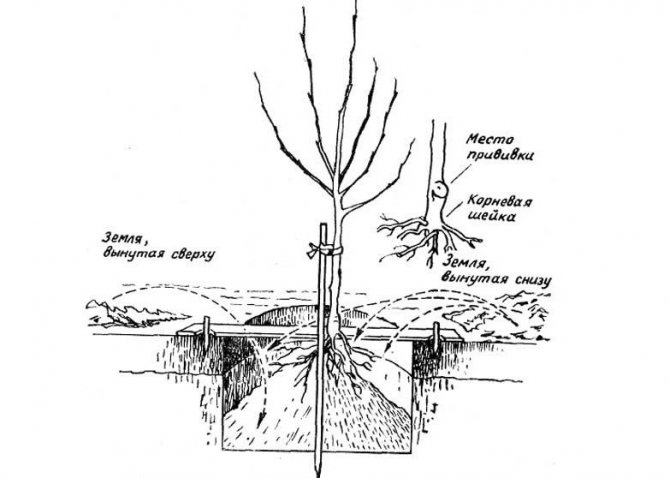

Pear planting scheme.
Plant in a sunny place


It is preferable to plant the pear of the Pamyati Yakovlev variety in early spring. Photo:
- Plant this pear in early spring.... If planting is expected in the fall, then do it 30 - 40 days before the first frost.
- Dig a planting hole depth 1.0 - 1.2 m and width 0.8 - 1.0 m. Large dimensions are associated with the fact that this pear has a well-developed root system with a powerful central conductor.
- Pre-remove the top fertile part of the soil to a depth of 20 cm and fold separately to the side.
- Mix it with fertilizers: superphosphate (200 g), potassium sulfate (60 g), humus (3 buckets) and sand (2 buckets).
- Pour a hole solution of dolomite flour or lime (for 1 bucket of water - 500 g).
- Fill in the prepared soil mixture slide into the pit.
- Cover the pit with a cloth for a week (before landing).
- Open the hole and place a peg 5 cm from the center, which will serve as a support for the seedling. Its height should be slightly higher than that of a tree.
- Place the seedling in the center of the hole on a hill of soil mixture and gently spread the roots along its slopes.
- Cover the root system in layersperiodically lightly tamping the soil to prevent voids from forming. The root collar should remain 5 to 6 cm above ground level.
- Tie the seedling to a support rope. Wire cannot be used for this purpose, as it can damage the bark.
- Make an irrigation groove around the perimeter of the trunk circle... So the water will not spread and will smoothly and evenly saturate the soil to the required depth.
- Water the seedling 2 - 3 buckets of water.
- Mulch the soil of the trunk circle a layer of peat 5 - 6 cm or other mulch.
The video shows in detail how to plant a pear tree correctly. The authors pay special attention to correct watering after planting:
Growing and care
Yakovlev's Memory Pear requires standard care; the tree does not show any special requirements for its cultivation. However, for those who do not have gardening experience and are just beginning to comprehend its basics, you should learn the main points that you need to pay attention to.
Watering and feeding (fertilizers)
Low drought resistance is one of the most unpleasant features of the Pamyati Yakovleva cultivar. Unlike most fruit trees, which are watered on average three times per season (in spring, during the ripening period and in preparation for winter), this type of pear needs more frequent watering. The lack of moisture for a tree becomes especially critical when it is grown in more southern latitudes than the zoning of the variety suggests. Young seedlings are also very sensitive to drought during the first few years after transplanting.
Important! To improve air exchange in the soil and protect it from weeds, experts recommend planting vegetables with a superficial root system between pears. This can be cabbage, pumpkin, peas or beans.
At this time, in the absence of rain, you need to water the pear 1-2 times a month, each time using at least 20 liters of water. As the tree matures, the frequency of watering can be reduced, however, during the period of fruit ripening, the moisture of the earth must be monitored very carefully, not forgetting that waterlogging for pear roots is just as dangerous as drying out. You can start feeding the variety in Memory of Yakovlev from the second year after planting.


The standard rule for the timing of mineral fertilization is:
- nitrogen fertilizers (ammonium nitrate, urea, etc.) - spring;
- potash fertilizers (potassium sulfate, wood ash) - summer;
- phosphate fertilizers (superphosphate) - autumn.
In addition, once every 2-3 years in spring or autumn, the tree needs to be fed with organic matter (manure, bird droppings, compost). Such fertilizers are applied for digging along the outer edge of the trunk circle so as not to damage or burn the roots.
It is also important to remember that any fertilization must be accompanied by abundant watering, otherwise the pear root system will not be able to assimilate the nutrients that have entered the soil.
Pruning and shaping crowns
The first stage of forming the crown of a pear in Memory of Yakovlev is carried out already at the stage of planting a seedling. For this purpose, the top and skeletal branches of a young tree are cut. In subsequent years, as the seedling grows, 2-3 lateral shoots directed in different directions are left on its trunk in each tier, pinching them at the level of 6-7 buds. In addition to formative pruning, sanitary pruning is also carried out.
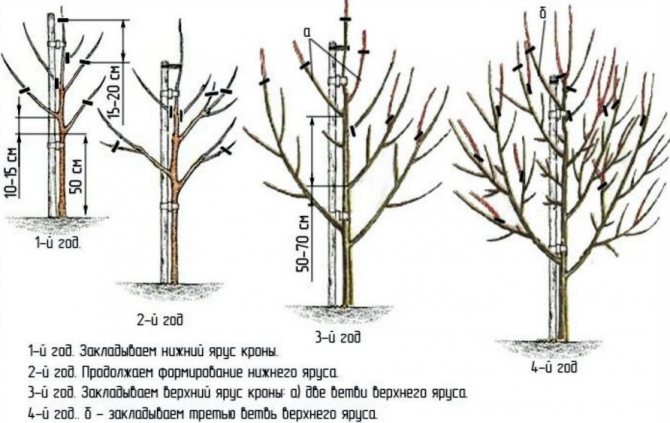

It consists in removing dried, frozen or broken branches and tops - shoots directed upwards at a very acute angle. Finally, another type of pruning to be aware of is called anti-aging. It is applied to aging trees and is necessary due to the fact that the pear begins to bear fruit worse and worse with age.
The essence of the procedure is to sequentially shorten all branches by approximately the same distance. Depending on the degree of neglect of the tree, the level of rejuvenating pruning can range from 20 cm to 1.5 m, but it must be borne in mind that the pear does not tolerate radical "interference" in its crown, so it is better not to start the state of the tree, carrying out pruning little by little. but every year.
Important! When carrying out the formation of the crown, one should strive to ensure that the angle of direction of all lateral branches in relation to the trunk is as close as possible to 90
º
, that is, the branches should grow almost horizontally.
Whitewash
This procedure is aimed at performing two independent functions:
- protect tree bark from sunburn;
- prevent insects from settling in cracks in the bark (or destroy them, if such a problem has already arisen).
Trunk whitewashing can be done in the spring or fall, and some farmers do it twice a year. The recipes for the whitewashing solution can be different, in particular, the specific composition depends on the main purpose of the procedure, the moment of its implementation (autumn or spring), the state of the tree, as well as the personal preferences of the gardener.
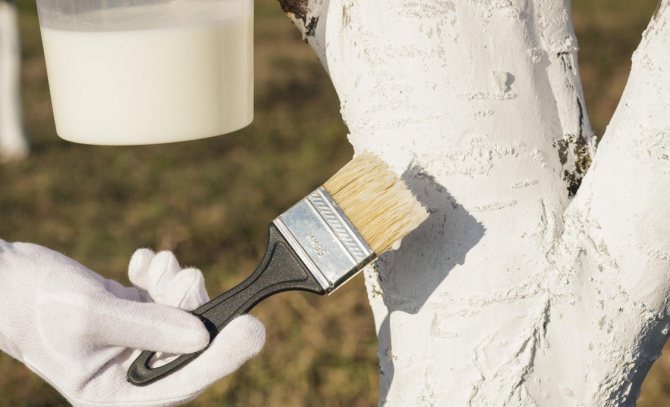

So, with a constant composition - a mixture of fluff lime and water - sometimes they add to the substance for treating the trunk:
- glue - carpentry, PVA or clerical (so that the product adheres better to the bark);
- copper sulfate (prevents wood from rotting);
- Birch tar (drives away rodents);
- hot pepper or insecticide (for the destruction of insects).
Processing methods and preparation for winter
The Pamyati Yakovlev variety is famous for its frost resistance, therefore, when growing a tree in the recommended zoning zone for it, preparation for winter comes down to performing standard procedures:
- thorough cleaning of the trunk circle from all organic residues;
- abundant watering of the tree, preventing freezing of its roots.
For additional insulation, it is also very useful to shove as much snow as possible to the tree as soon as it falls. However, the first 2-3 years after planting the seedling, the young tree needs to be protected from frost more carefully.
Important! It is strictly forbidden to leave fallen fruits on the ground. It is they, along with cracks in the bark, that are a favorite wintering place for insects and fungi parasitizing this species.
To do this, cover the trunk circle with a thick layer of mulch (preferably peat). You cannot use the fallen foliage for shelter, since various pests hibernate in it, as in fruits, but if there is no other suitable material at the gardener's disposal, you can cover the near-trunk circle with agrotechnical fiber, and lay a layer of leaves on top of it.
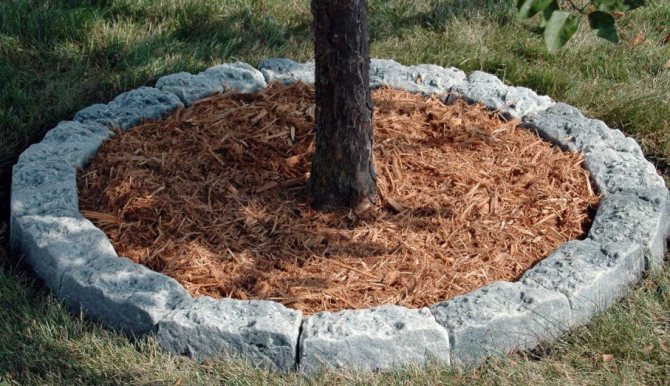

In this case, it is necessary to remove the shelter before the spring sun wakes up the "living creatures" hiding in the foliage. For the winter, the trunk of a young seedling should be wrapped with light burlap or the same agrofibre, which will protect the tree from being eaten by rodents.
Pruning pear
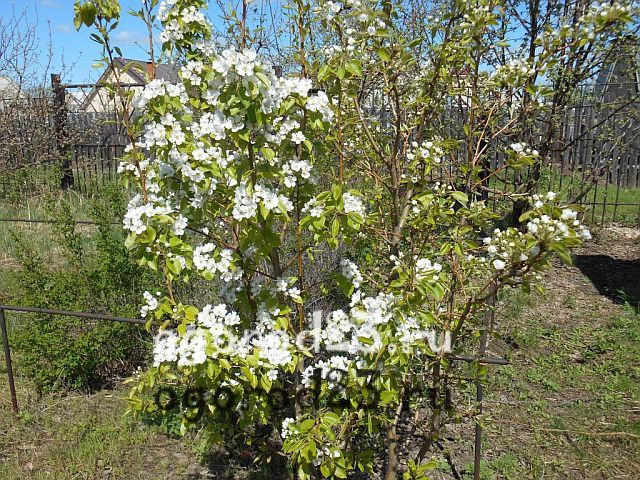

Paying attention to pruning, it is worth mentioning that this procedure is carried out throughout the entire life cycle of the pear. Illiterate pruning can adversely affect fruiting, so the purpose of this event is to get rid of the tree from all that is superfluous. However, being too diligent can also be harmful, so balance is important in this matter.
In spring, old branches are pruned, and some are shortened - this action limits the growth of the tree and activates the appearance of new buds. A pear of this variety loves light (as, in principle, all pears do), therefore, it requires pruning every spring to thin out the crown. A correctly formed crown evenly distributes the load of the fruits, allows you to easily get to them during harvesting, and also makes it possible to more conveniently carry out protective irrigation. The sun's rays and air more easily penetrate through the thinned crown.
The very first pruning is carried out after planting the seedling, as soon as the tree is 1 year old. Subsequent procedures are carried out twice a year, they are aimed at enhancing the overall growth of branches and the appearance of fruit. The purpose of the so-called "age" pruning is to rejuvenate the tree. In this case, the top of the crown is shortened by half or by a third. All branches are pruned. At the bottom, 5 thick skeletal branches are left. With this type of pruning, they try to shape the crown into an umbrella. For these purposes, you need to use only sharpened tools so that the cut is even and less traumatic for the tree. Do not forget to process the cut with garden pitch.
Pests and diseases of the Pamyati Yakovlev variety
The variety is highly resistant to diseases and pests, but the occurrence of such problems remains very likely.
Did you know? The body of a caterpillar includes about four thousand muscles, while a person has them, depending on the method of calculation, from 649 to 850.
In particular, the most dangerous pear diseases include:
- powdery mildew;
- scab;
- septoria;
- cytosporosis;
- fruit rot;
- brown spotting;
- sooty mushroom;
- rust;
- gray rot;
- black cancer;
- bacteriosis;
- ring mosaic.
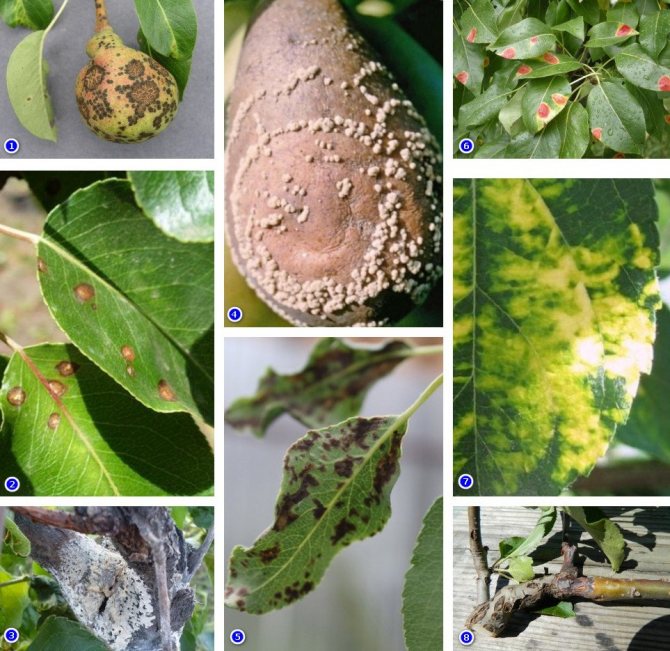

1 - scab; 2 - Septoria; 3 - Cytosporosis; 4 - Fruit rot; 5 - Brown spot; 6 - Rust; 7 - Ring mosaic; 8 - Black cancer.
The list of insects and other pests that parasitize the pear is also impressive.
It includes, for example:
- scoops;
- moths;
- leaflets;
- ticks;
- mole;
- fruit flies;
- gall midges;
- moths;
- sawflies;
- coppers, etc.


1 - Leafworm on a pear; 2 - Pear fruit gall midge; 3 - Pear Copperhead; 4 - Scoop; 5 - Pear mite; 6 - Fruit moth; 7 - moth; 8 - Fruit fly.Since in the middle of summer, when most fungal infections and insects parasitizing on fruit trees become more active, there are already ovaries or ripening fruits on the pear, it is no longer possible to treat the garden with pesticides at this time. For this reason, the only adequate way to preserve the tree and the crop is to use preventive measures, that is, to process the tree not after it has been affected, but before that. The main control of pests and diseases in the orchard is carried out in the spring.
Find out what a pear is and what its features are.
In the classic version, three consecutive treatments of trees with insecticidal and fungicidal preparations are used - after swelling of the buds, on the buds and after flowering. For these purposes, Bordeaux liquid, urea, ferrous sulfate or colloidal sulfur are usually used, but you can also purchase special chemicals such as Topaz, Skor, HOM, Karbofos, Fufanon, BI-58 "," Clean Garden "," Inta-Vir "," Strobe ", etc.
Further care of the autumn variety
Further we take care of pears like apple trees... Watering is required plentiful, especially if the summer is dry. Weeding of the near-stem circle from weeds. Fertilizing and disease control.
Although the Pamyati Yakovlev variety is not exposed to scab, preventive work should be carried out. To do this, in the spring, treat the trees with Bordeaux liquid.
The difference in pear care is covered with a lot of snow in winter... Some gardeners douse the bole with water before freezing.
It is covered with ice, which protects the pear from freezing. Since young pears are more prone to freezing than apple trees.
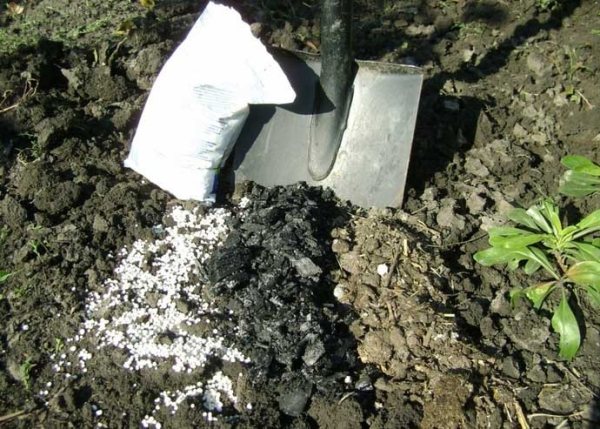

A pear needs fertilizers: nitrogen, carbide, urea, potassium, phosphorus, superphosphate
We use fungicides for prophylaxis against diseases. Spray in early spring or late autumn plants 3% Bordeaux mixture.
During the flowering pear you can use drugs Strobi or Inta-Vir.
Fertilizers can be scattered over the snow in early spring. Nitrogen with urea or urea is introduced. In the summer, add potassium together with watering. Phosphorus is required after the growing season. Add superphosphate while digging.
How to form a crown in a pear
The crown of pears usually forms naturally.so no special trimming is required. But now, if the branches are frozen, then they form many spinning tops.
In this case, some of these shoots should be cut off, and the rest should be given a horizontal position. Pear bears fruit only on horizontal branches.
Collection, transportability and storage of crops
As a rule, experienced gardeners try to harvest pears before the fruits reach full biological ripeness. The fact is that such pears are stored much better and, in addition, as they ripen, the fruits often do not hold on to the stalks and crumble, and the so-called volunteer spoils very quickly. However, the variety Pamyati Yakovlev is a rare and pleasant exception to the rule. Its harvest can be harvested both at the stage of technical ripeness and after full ripening.
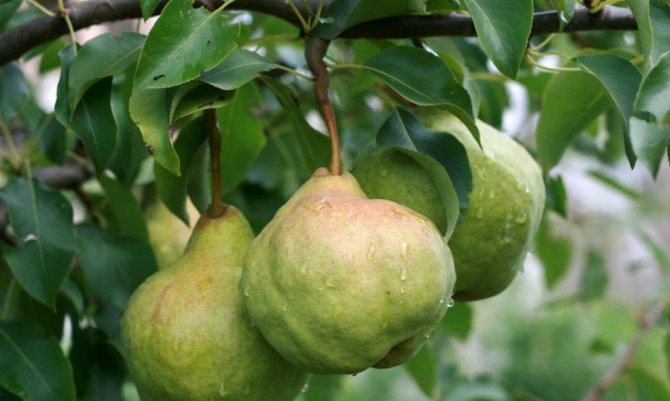

And in fact, and in another case, pears are perfectly retained on the tree and subsequently are equally well stored. The optimal place for storing the pear harvest is the cellar, the optimal container is wooden or cardboard boxes. It is best to put the fruits in them in one layer, putting the pears vertically, with the stalk up. This way they will deform less, which means they will remain usable longer. If these requirements are met, the harvest in Memory of Yakovlev, harvested in October, can be preserved without any problems until March.
Also learn about how the pear affects the stool of children and adults.
In memory of Yakovlev, this is a well-tested classic.Having planted such a tree on the site, you can not be afraid to face unpleasant surprises typical for newfangled novelties. Of course, this pear also has disadvantages, but still, for a novice gardener, an unpretentious and resistant to various diseases variety is perfect.
Sapling selection
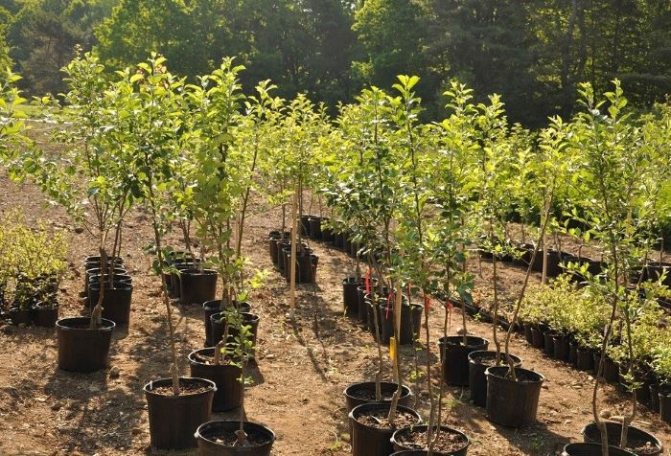

Saplings are best purchased from a specialized nursery.
Before planting, you should choose the right young seedling. His condition will become a guarantee of high yields.
The healthy appearance of the seedling is an important aspect, since lethargy and dark spots should be completely absent. The bark should be slightly dry and the roots healthy. It is not worth buying seedlings on the market, since already grafted samples can be purchased in nurseries.
Landing
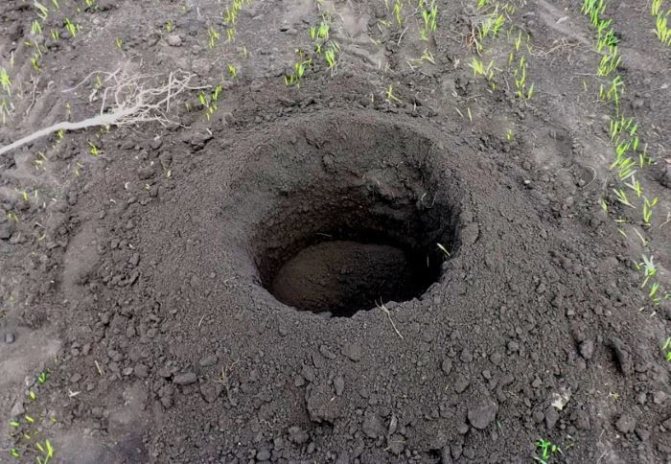

The seedling pit is prepared in advance, at least half a month before planting.
- To begin with, a hole is prepared, in the center of which a peg is placed. In length, it should be higher than the seedling itself (half a meter is enough).
- Before compacting the soil, the roots must be straightened.
- The root system is covered with previously dug earth. There should be no voids between the roots, so the tree should be shaken slightly before planting.
- The root collar should be several centimeters above the ground level.
- After sprinkling with soil, it should be lightly tamped, but not hard, so as not to break the roots.
- But you will also need abundant watering in several passes... To reduce the number of weeds, the peri-stem circle is regularly mulched.


